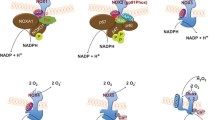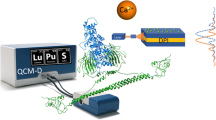Abstract
The present study was designed to probe the possible role of singlet oxygen and superoxide anion radical modified DNA in the etiopathogenesis of Systemic lupus erythematosus. These species were generated by the exposure of riboflavin to 365 nm UV light. Modified DNA showed single strand breaks, hyperchromicity at 260nm and decrease in Tm. The modified DNA induced high titer antibodies in experimental animals. The antibodies showed reactivity with various nucleic acid polymers, a property commonly associated with Systemic lupus erythematosus anti-DNA autoantibodies. Systemic lupus erythematosus sera showed preferential binding of modified DNA over native DNA in direct binding and competitive binding solid phase immunoassays and band shift assays. The results suggest for the possible involvement of the singlet- superoxide modified DNA as a potential trigger for anti- DNA autoantibody production in SLE and thus in the etiopathogenesis of the disease.
Similar content being viewed by others
References
Kimberly RP. Prospects of autoimmune disease: Research advances in systemic lupus erythematosus. J Ann Med Assoc 2001; 285:650–651.
Chastagner P, Demaison C, Teze J, Zouali M. Clonotypic dominance and variable gene elements of pathogenic anti-DNA autoantibodies from a single patient with lupus. Scand J Immunol 1994; 39:165–178.
Pisetsky DS, Grudier JP, Gillkeson GS. A role of immunogenic DNA in the pathogenesis of systemic lupus erythematosus. Arth Rheum 1990; 33:153–159.
Stollar BD. Antibodies to DNA. CRC Crit Rev Biochem 1986; 20:1–36.
Stollar BD. Immunochemistry of DNA. Int Rev Immunol 1989; 5:1–22.
Arif Z, Ali R. Antigenicity of poly (dA-dT).poly (dA-dT) photocrosslinked with 8-methoxypsoralen. Arch Biochem Biophys 1996; 329:191–198.
Arjumand S, Arif Z, Ali A, Ali R. Native DNA fragments photocrosslinked to psoralen binds to anti-B and anti-Z DNA antibodies. Immunol Lett 1995; 48:215–219.
Burlingame RW, Doey ML, Starkebaum G, Rubin RL. The central role of chromatin in autoimmune responses to histone and DNA in systemic lupus erythematosus. J Clin Invest 1994; 94:184–193.
Mamula MJ. From peptides to particles. Immunol Rev 1995; 144: 301–304.
Fridovich I. Biological effects of the superoxide radicals. Arch Biochem Biophys 1986; 247:1–11.
Devasagayam TPA, Steenken S, Obendorf MSW, Schulz WA, Sies H. Formation of 8-hydroxy (deoxy) guanosine and generation of strand breaks at guanine residues in DNA by singlet oxygen. Biochem 1991; 30:6283–6289.
Halliwell B. Oxidants and human diseases: Some new concepts. FASEB J 1987; 1: 358–364.
McCord JM. Oxygen-derived free radicals in postischemic tissue injury. New Engl J Med 1985; 312:159–163.
Cross CE, Halliwell B, Borish ET, Pryor WA, Ames BN, Saul RL, McCord JM, Harman D. Oxygen radicals and human disease. Ann Intern Med 1987; 107:526–545.
Epe B, Mutzel P, Adam W. DNA damage by oxygen radicals and excited state species, a comparative study using enzymatic probes in vitro. Chem Bio Interact 1988; 67: 149–165.
Eisenberg WC, Taylor K, Schiff LJ. Biological effects of singlet delta oxygen on respiratory tract epithelium. Experiential 1984; 40:514–515.
Dubbelman TMAR, Smeets M, Boegheim JPJ. Cell Models. In Moreno G, Pottier R and Triscott TG (eds): Photosensitization, Molecular, Cellular and medical Aspects NATO ASI, Springer, Berlin, 1988; 157–170.
Foote CS. Photosensitized oxidation and singlet oxygen: consequences in biological systems. Free Rad Bio 1976; 2: 85–133.
Joshi PC. Copper (II) as on efficient scavenger of singlet oxygen. Ind J Biochem Biophys 1987; 35: 208–215.
Wefers H, Schulte-Frohlinde D, Sies H. Loss of transforming activity of plasmid DNA (pBR 322) in E.Coli caused by singlet molecular oxygen. FEBS Lett 1987; 211:49–52.
Floyd RA, West MS, Eneff KL, Schneider JE. Mediation of 8-hydroxy-guanine formation in DNA by thiazine dyes plus light. Free Rad Bio Med 1990; 8:327–330.
Ali R, Der Simonian H, Stollar BD. Binding of monoclonal anti-native DNA antibodies to DNA of varying size and conformation. Mol Immunol 1985; 22:1415–1422.
Waris G, Ahsan H, Alam K. Evidence for the possible involvement of O2 .− modified DNA in the etiopathogenesis of systemic lupus erythematosus. J Biochem Mol Biol Biophys 1999; 4: 9–16.
Kraljic I, Moshni EIS. New method for the detection of singlet oxygen in aqueous solution. Photochem Photobiol 1978; 28: 577–581.
Beauchamp C, Fridovich I. Superoxide dismutase: improved assays and an assay applicable to gels. Anal Biochem 1971; 44:276–287.
Ashok BT, Ali R. Binding of human anti-DNA autoantibodies to reactive oxygen modified DNA and probing oxidative DNA damage in cancer using monoclonal antibody. Int J Cancer 1998; 78:404–409.
Dixit K, Ali R. Antigen binding characteristics of antibodies induced against nitric oxide modified plasmid DNA. Biochim Biophys Acta 2001; 528: 1–8.
Ali R, Alam K. Evaluation of antibodies against oxygen free radical modified DNA by ELISA. In Armstrong ED (ed): Oxidative Stress Biomarkers and Antioxidant Protocols. U.S.A., Humana Press, 2002; 171–181.
Alam K, Ali R. Human autoantibodies binding to multiple conformations of DNA. Biochem Int 1992; 26:597–605.
Piette J. Biological consequences associated with DNA oxidation mediated by singlet oxygen. J Photochem B Biol 1991; 11: 241–260.
Epe B. Genotoxicity of singlet oxygen. Chem Biol Interact 1991; 80: 239–260.
Mansoor F, Ali A, Ali R. Binding of circulating SLE autoantibodies to oxygen free radical damaged chromatin. Autoimmunity 2005; 38(6): 431–438.
Blount S, Griffiths HR, Lunce J. Reactive oxygen species induce antigenic changes in DNA. FEBS Lett 1989; 245: 100–104.
Al Arfaj AS, Chowdhary AR, Khalil N, Ali R. Immunogenicity of singlet oxygen modified human DNA: implications for anti DNA autoantibodies in systemic lupus erythematosus. Clin Immunol 2007; 124(1): 83–89.
Lunec J, Herbert K, Blount S, Griffiths HR, Emery P. 8-hydroxydeoxyguanosine. A marker of oxidative DNA damage in systemic lupus erythematosus. FEBS Lett 1994; 348: 131–138.
Ahsan H, Ali A, Ali R. Oxygen free radicals and systemic autoimmunity. Clin Exp Immunol 2003; 131: 398–404.
Author information
Authors and Affiliations
Corresponding author
Rights and permissions
About this article
Cite this article
Khan, S., Alam, R., Moinuddin et al. Oxygen free radical modified DNA: Implications in the etiopathogenesis of Systemic lupus erythematosus. Indian J Clin Biochem 24, 123–130 (2009). https://doi.org/10.1007/s12291-009-0023-0
Published:
Issue Date:
DOI: https://doi.org/10.1007/s12291-009-0023-0




